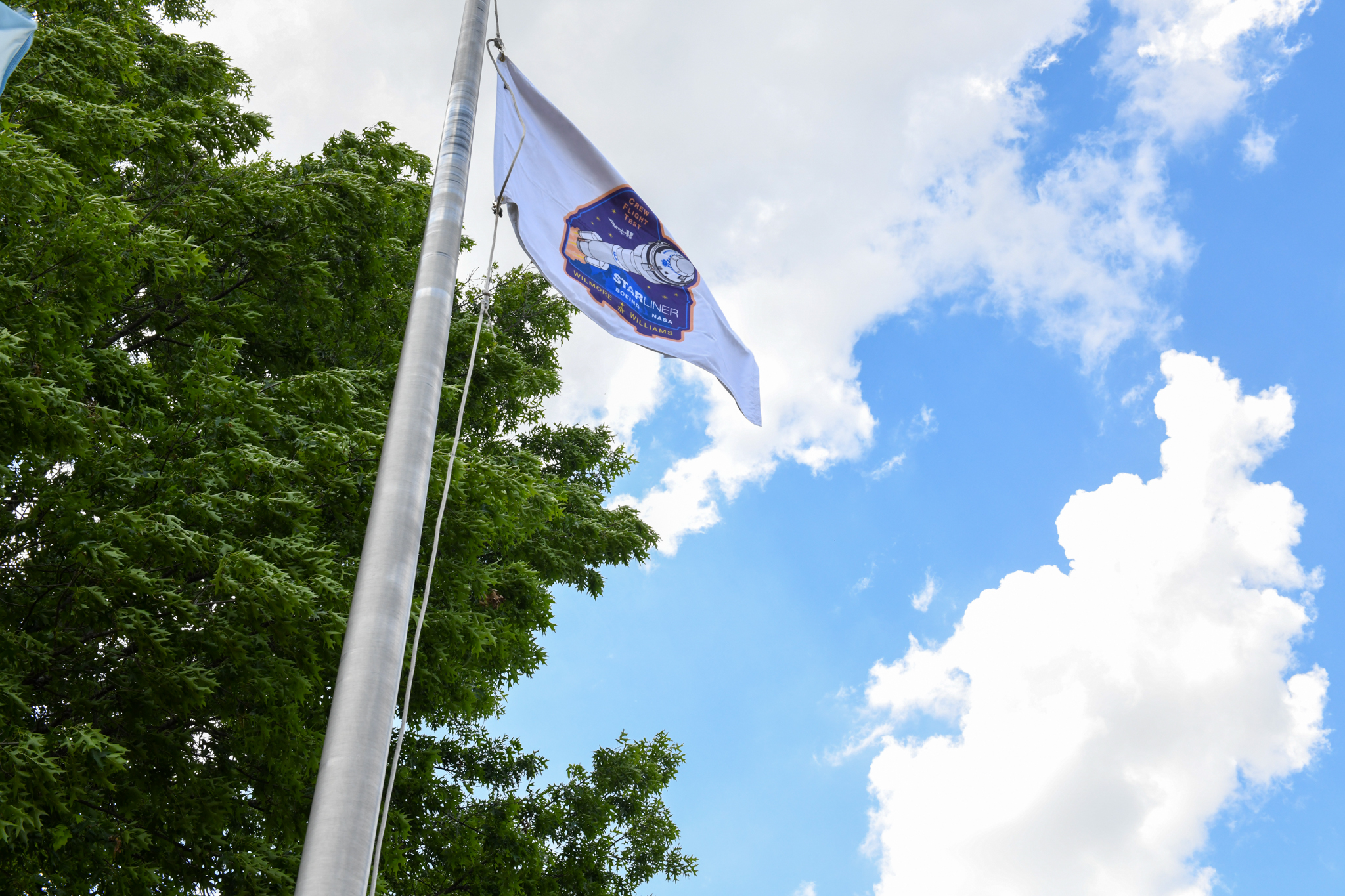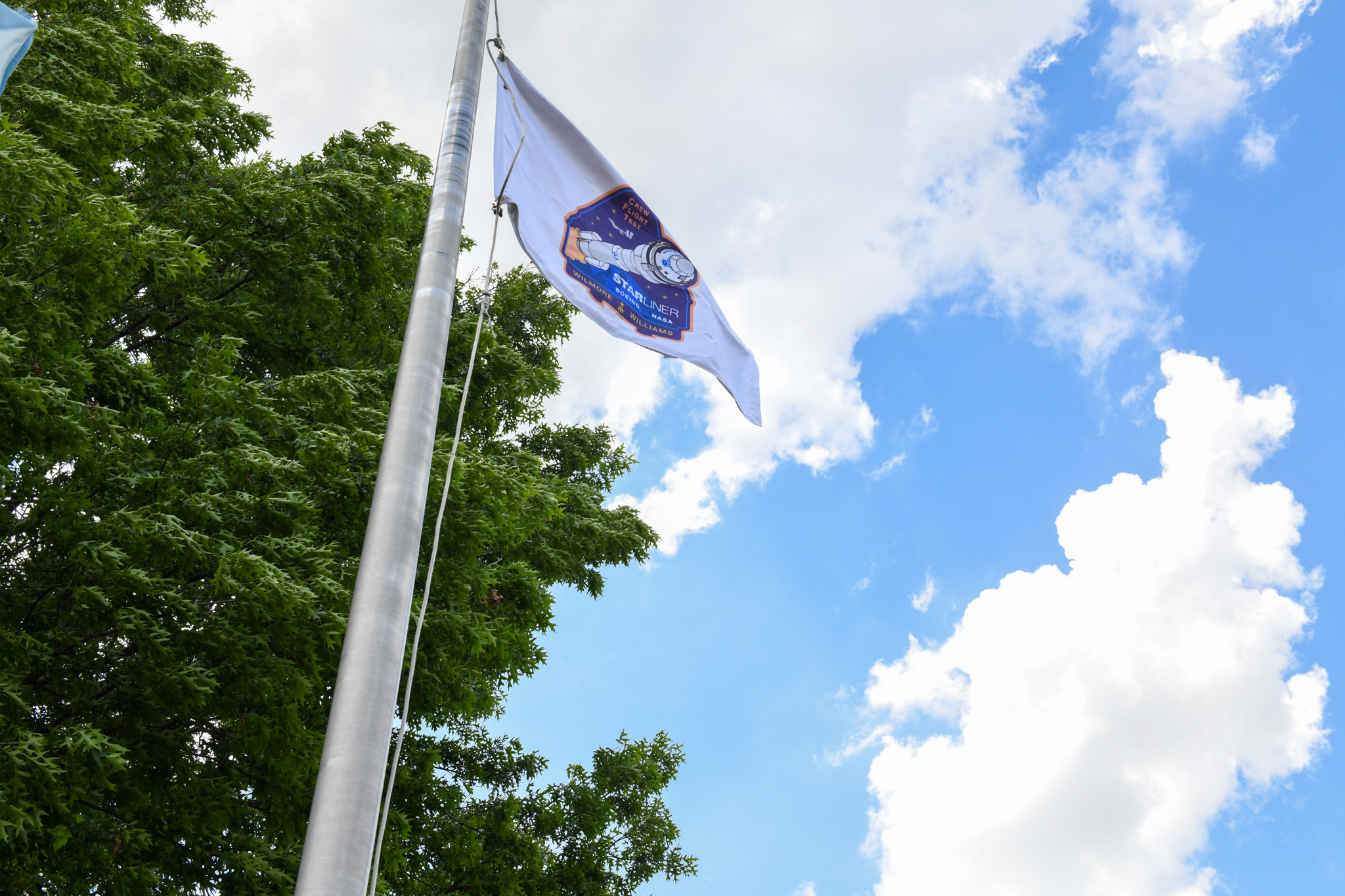20 Min Read The Marshall Star for May 8, 2024 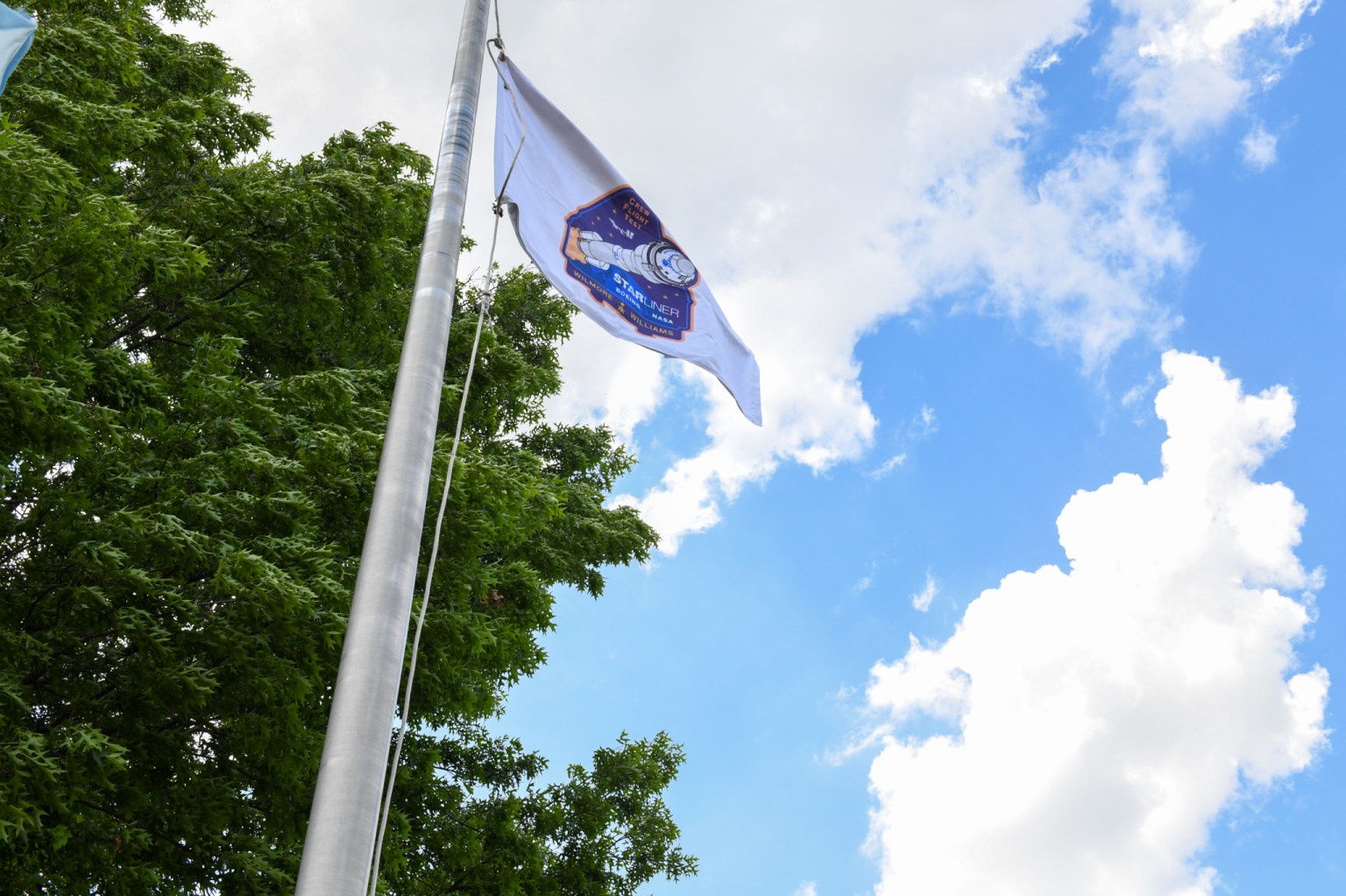 New Flag is in the Stars for Marshall’s Huntsville Operations Support Center By Wayne Smith
New Flag is in the Stars for Marshall’s Huntsville Operations Support Center By Wayne Smith
A new flag is flying closer to the stars outside the Huntsville Operations Support Center at NASA’s Marshall Space Flight Center following a May 2 ceremony.
The white flag features a blue logo of Boeing’s Starliner spacecraft and marks contributions from center team members toward the launch of NASA’s Boeing Crew Flight Test, now targeted to launch no earlier than 5:16 p.m. CDT May 17. The flag-raising ceremony was held ahead of the planned launch of the spacecraft atop a United Launch Alliance Atlas V rocket from Space Launch Complex 41 at Cape Canaveral Space Force Station.
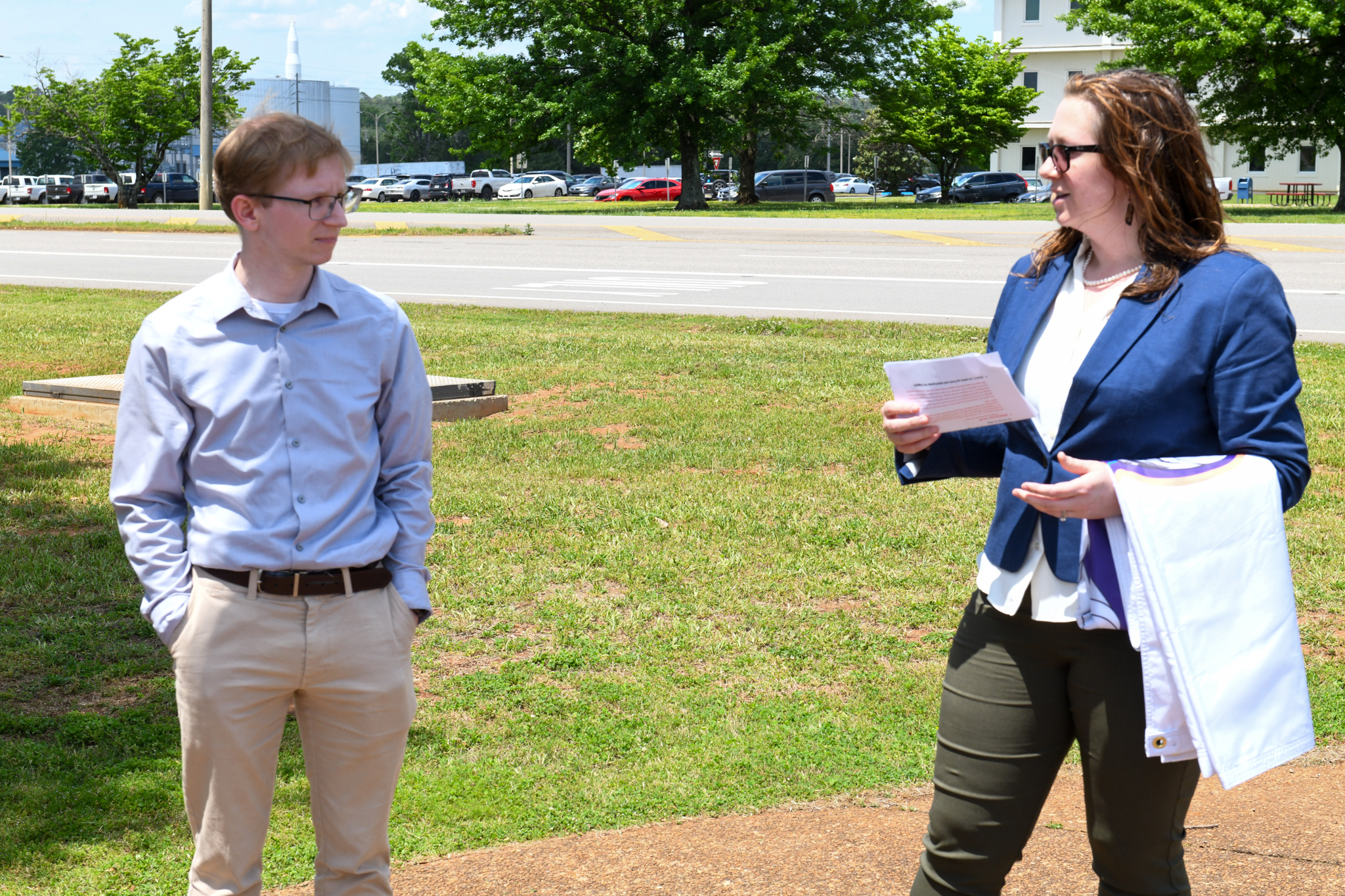 Chris Chiesa, left, listens as Lisa McCollum, deputy manager of the Exploration & Transportation Development Office, talks about Chiesa’s recognition as part of the Commercial Crew Program at NASA’s Marshall Space Flight Center during the Starliner flag-raising ceremony May 2. NASA/Tyson Eason The flight test will carry NASA astronauts Butch Wilmore and Suni Williams to the International Space Station for about a week to test the Starliner spacecraft and its subsystems before NASA certifies the transportation system for rotational missions to the orbiting laboratory for the agency’s Commercial Crew Program.
Chris Chiesa, left, listens as Lisa McCollum, deputy manager of the Exploration & Transportation Development Office, talks about Chiesa’s recognition as part of the Commercial Crew Program at NASA’s Marshall Space Flight Center during the Starliner flag-raising ceremony May 2. NASA/Tyson Eason The flight test will carry NASA astronauts Butch Wilmore and Suni Williams to the International Space Station for about a week to test the Starliner spacecraft and its subsystems before NASA certifies the transportation system for rotational missions to the orbiting laboratory for the agency’s Commercial Crew Program.
The flag raising has been a tradition for missions supported at Marshall’s Huntsville Operations Support Center, or HOSC, as well as a tradition within the Commercial Crew Program to celebrate the successful conclusion of NASA’s Agency Flight Readiness Review prior to launch. The ceremony was a joint effort between the Payload and Mission Operations Division (PMOD) and Commercial Crew Program team.
“The ceremony is special because it symbolizes the successful conclusion of NASA’s Flight Readiness Review, bringing us that much closer to flight,” said Maggie Freeman, a program analyst supporting the Launch Vehicle Systems Office within the Commercial Crew Program at Marshall. “It’s also a privilege to be able to honor some of our Marshall team members who have supported the mission.”
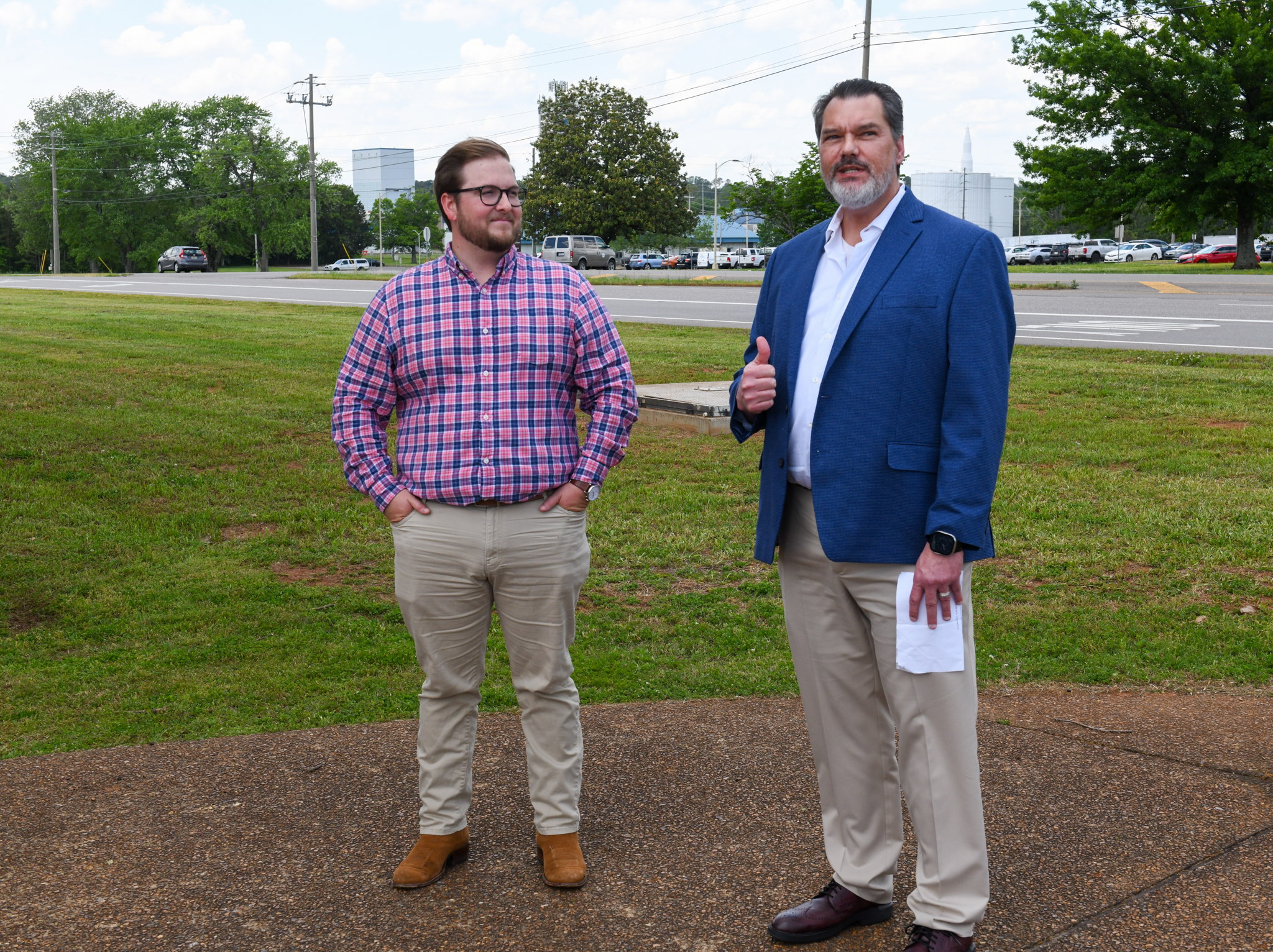 Brandyn Rolling, left, of the Payload Missions Operation Division at Marshall, listens as George Norris, deputy manager of the Payload & Mission Operations Division, talks about Rolling’s recognition during the Starliner flag-raising ceremony outside the Huntsville Operations Support Center on May 2. NASA/Tyson Eason Chris Chiesa and Brandyn Rolling were honored during the ceremony and raised the Starliner flag after being introduced by Lisa McCollum, deputy manager for the Exploration & Transportation Development Office, and George Norris, deputy manager for the Payload & Mission Operations Division.
Brandyn Rolling, left, of the Payload Missions Operation Division at Marshall, listens as George Norris, deputy manager of the Payload & Mission Operations Division, talks about Rolling’s recognition during the Starliner flag-raising ceremony outside the Huntsville Operations Support Center on May 2. NASA/Tyson Eason Chris Chiesa and Brandyn Rolling were honored during the ceremony and raised the Starliner flag after being introduced by Lisa McCollum, deputy manager for the Exploration & Transportation Development Office, and George Norris, deputy manager for the Payload & Mission Operations Division.
“We look for team members who have displayed excellence within their fields, demonstrating their commitment to the goals of the mission,” Freeman said. “Chris and Brandyn both are phenomenal examples of that sustained commitment to excellence.”
Chiesa is the NASA engine lead for the Starliner spacecraft for the Commercial Crew Program. Rolling represented PMOD and manages all of the HOSC’s visiting vehicle ground interfaces for NASA.
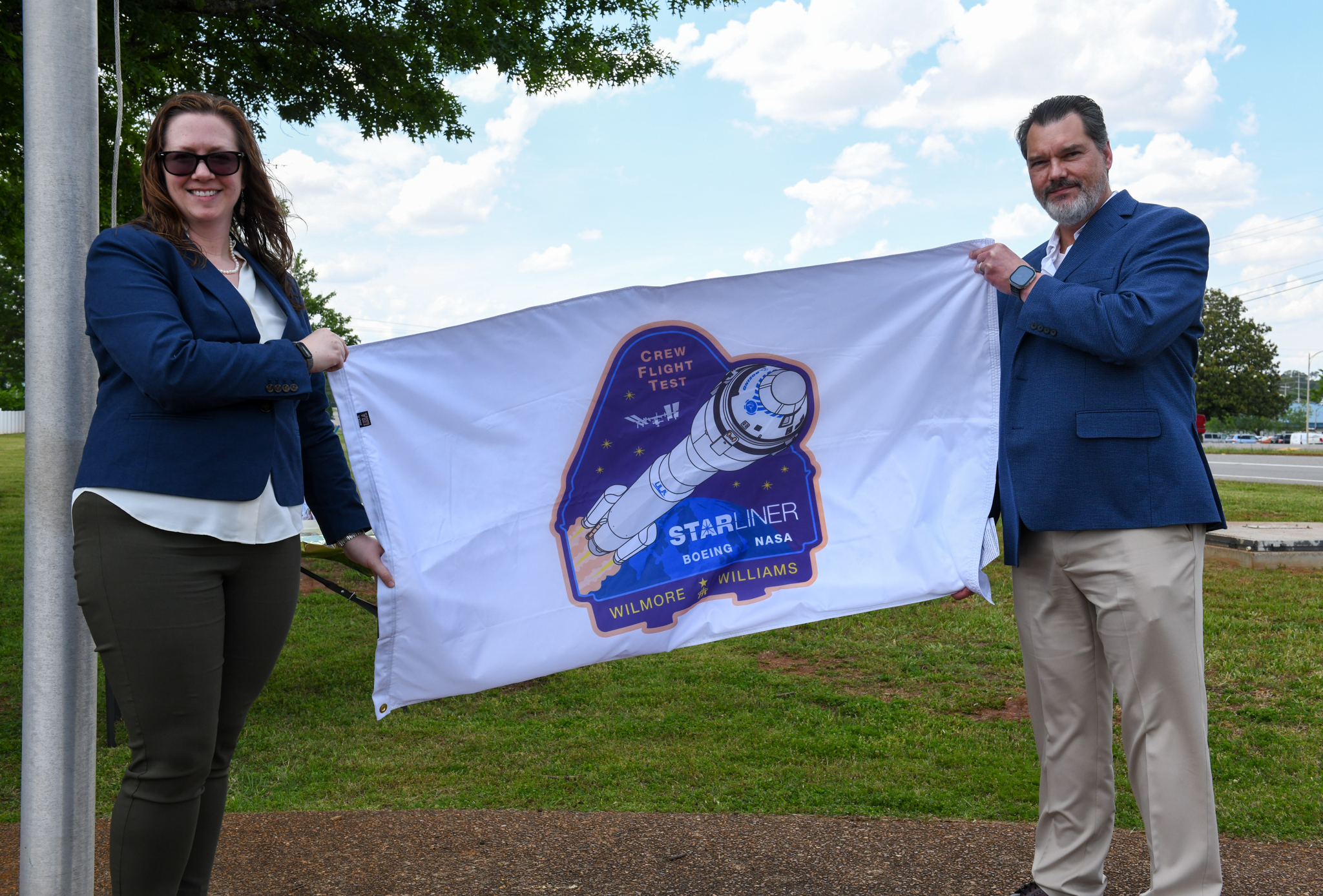 McCollum and Norris display the Starliner flag before it was raised outside the Huntsville Operations Support Center. NASA/Tyson Eason “I feel tremendously fortunate to be surrounded by such an incredible team and to have the support of so many amazing engineers and managers across Marshall, Kennedy, and Johnson (space flight centers),” Chiesa said.
McCollum and Norris display the Starliner flag before it was raised outside the Huntsville Operations Support Center. NASA/Tyson Eason “I feel tremendously fortunate to be surrounded by such an incredible team and to have the support of so many amazing engineers and managers across Marshall, Kennedy, and Johnson (space flight centers),” Chiesa said.
Said Rolling, “I am incredibly honored to be a part of this amazing PMOD team and am excited for the future of Boeing’s crewed flights with Starliner.”
The HOSC provides engineering and mission operations support for the space station, the Commercial Crew Program, and Artemis missions, as well as science and technology demonstration missions. The Payload Operations Integration Center within HOSC operates, plans, and coordinates the science experiments onboard the space station 365 days a year, 24 hours a day.
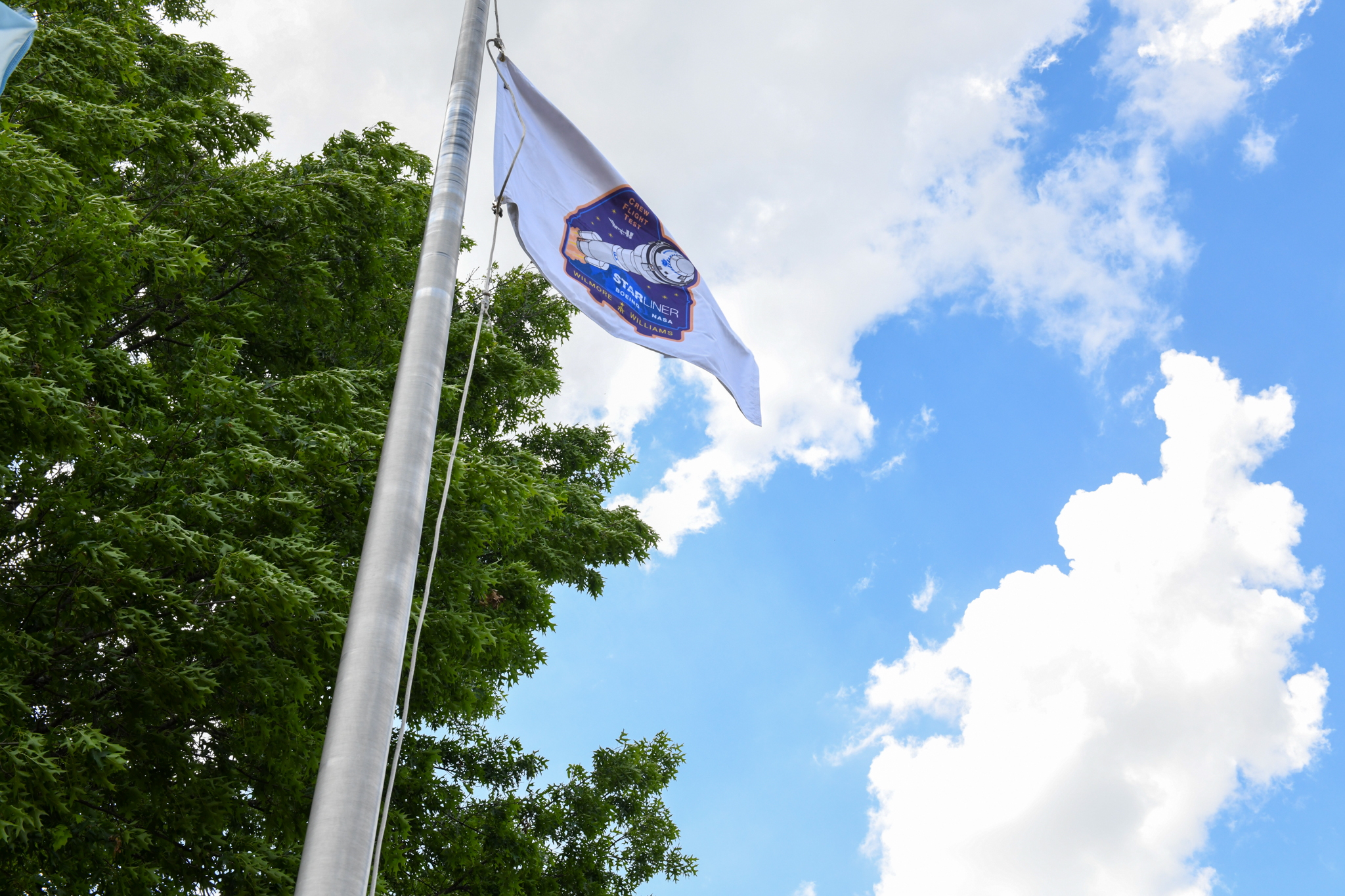 The Starliner flag flies outside the Huntsville Operations Support Center.NASA/Tyson Eason The Commercial Crew Program support team at Marshall provides crucial programmatic, engineering, and safety and mission assurance expertise for launch vehicles, spacecraft propulsion, and integrated vehicle performance.
The Starliner flag flies outside the Huntsville Operations Support Center.NASA/Tyson Eason The Commercial Crew Program support team at Marshall provides crucial programmatic, engineering, and safety and mission assurance expertise for launch vehicles, spacecraft propulsion, and integrated vehicle performance.
Smith, a Media Fusion employee and the Marshall Star editor, supports the Marshall Office of Communications.
NASA’s Boeing Crew Flight Test Targets New Launch Date NASA’s Boeing Crew Flight Test is now targeted to launch no earlier than 5:16 p.m. CDT May 17 to the International Space Station. Following a thorough data review completed May 7, ULA (United Launch Alliance) decided to replace a pressure regulation valve on the liquid oxygen tank on the Atlas V rocket’s Centaur upper stage.
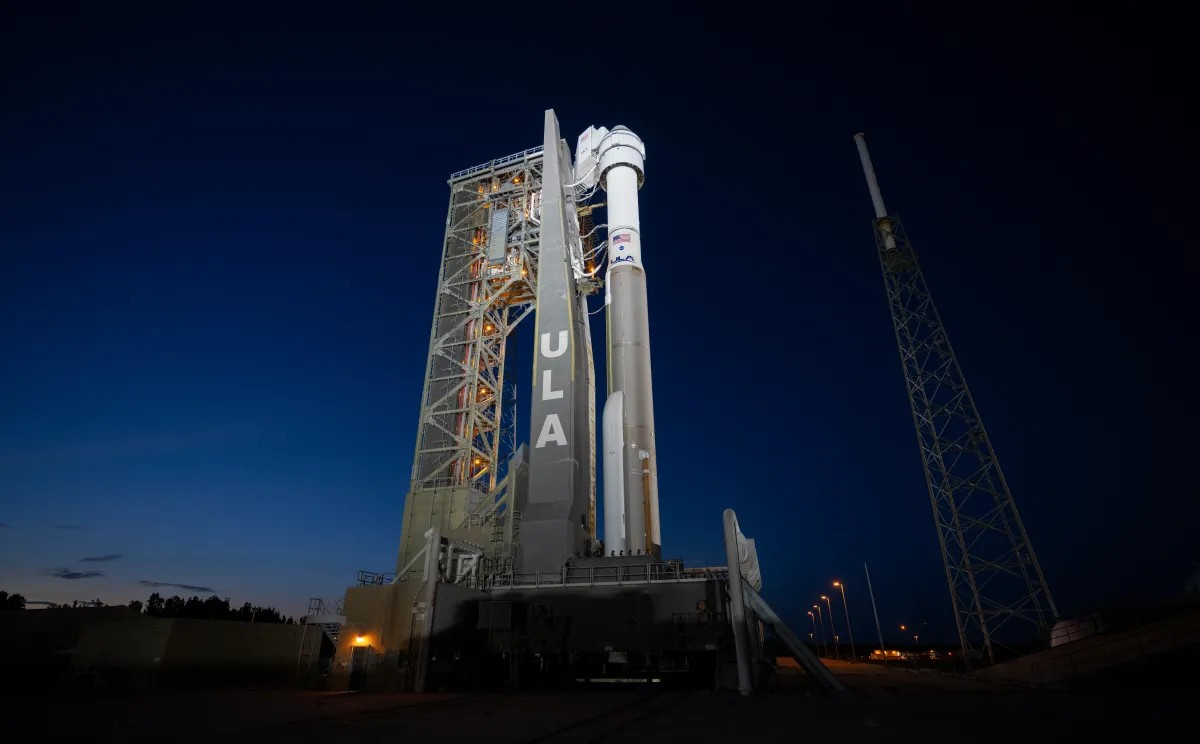 A United Launch Alliance Atlas V rocket with Boeing’s Starliner spacecraft atop illuminated by spotlights sits on the launch pad of Space Launch Complex 41 at Cape Canaveral Space Force Station ahead of NASA’s Boeing Crew Flight Test. It is the first Starliner mission to send astronauts to the International Space Station as part of the agency’s Commercial Crew Program. NASA/Joel Kowsky ULA planned to roll the rocket, with Boeing’s Starliner spacecraft, back to its Vertical Integration Facility at Cape Canaveral Space Force Station on May 8 to begin the replacement. The ULA team will perform leak checks and functional checkouts in support of the next launch attempt.
A United Launch Alliance Atlas V rocket with Boeing’s Starliner spacecraft atop illuminated by spotlights sits on the launch pad of Space Launch Complex 41 at Cape Canaveral Space Force Station ahead of NASA’s Boeing Crew Flight Test. It is the first Starliner mission to send astronauts to the International Space Station as part of the agency’s Commercial Crew Program. NASA/Joel Kowsky ULA planned to roll the rocket, with Boeing’s Starliner spacecraft, back to its Vertical Integration Facility at Cape Canaveral Space Force Station on May 8 to begin the replacement. The ULA team will perform leak checks and functional checkouts in support of the next launch attempt.
The oscillating behavior of the valve during prelaunch operations, ultimately resulted in mission teams calling a launch scrub May 6. After the ground crews and astronauts Butch Wilmore and Suni Williams safely exited from Space Launch Complex-41, the ULA team successfully commanded the valve closed and the oscillations were temporarily dampened. The oscillations then re-occurred twice during fuel removal operations. After evaluating the valve history, data signatures from the launch attempt, and assessing the risks relative to continued use, the ULA team determined the valve exceeded its qualification and mission managers agreed to remove and replace the valve.
Mission managers discussed the details leading to the decision to scrub the May 6 launch opportunity during a news conference shortly after the scrub call at NASA’s Kennedy Space Center.
Wilmore and Williams will remain in crew quarters at Kennedy in quarantine until the next launch opportunity. The duo will be the first to launch aboard Starliner to the space station as part of the agency’s Commercial Crew Program.
Hi-C Rocket Experiment Achieves Never-Before-Seen Look at Solar Flares By Jessica Barnett
After months of preparation and years since its last flight, the upgraded High Resolution Coronal Imager Flare mission – Hi-C Flare, for short – took to the skies for a never-before-seen view of a solar flare.
The low-noise cameras – built at NASA’s Marshall Space Flight Center – are part of a suite of state-of-the-art instruments on board the Black Brant IX sounding rocket that launched April 17 from Poker Flat Research Range in Alaska. Using the new technology, investigators hoped to study the extreme energies involved with solar flares. The Hi-C Flare experiment mission was led by Marshall.
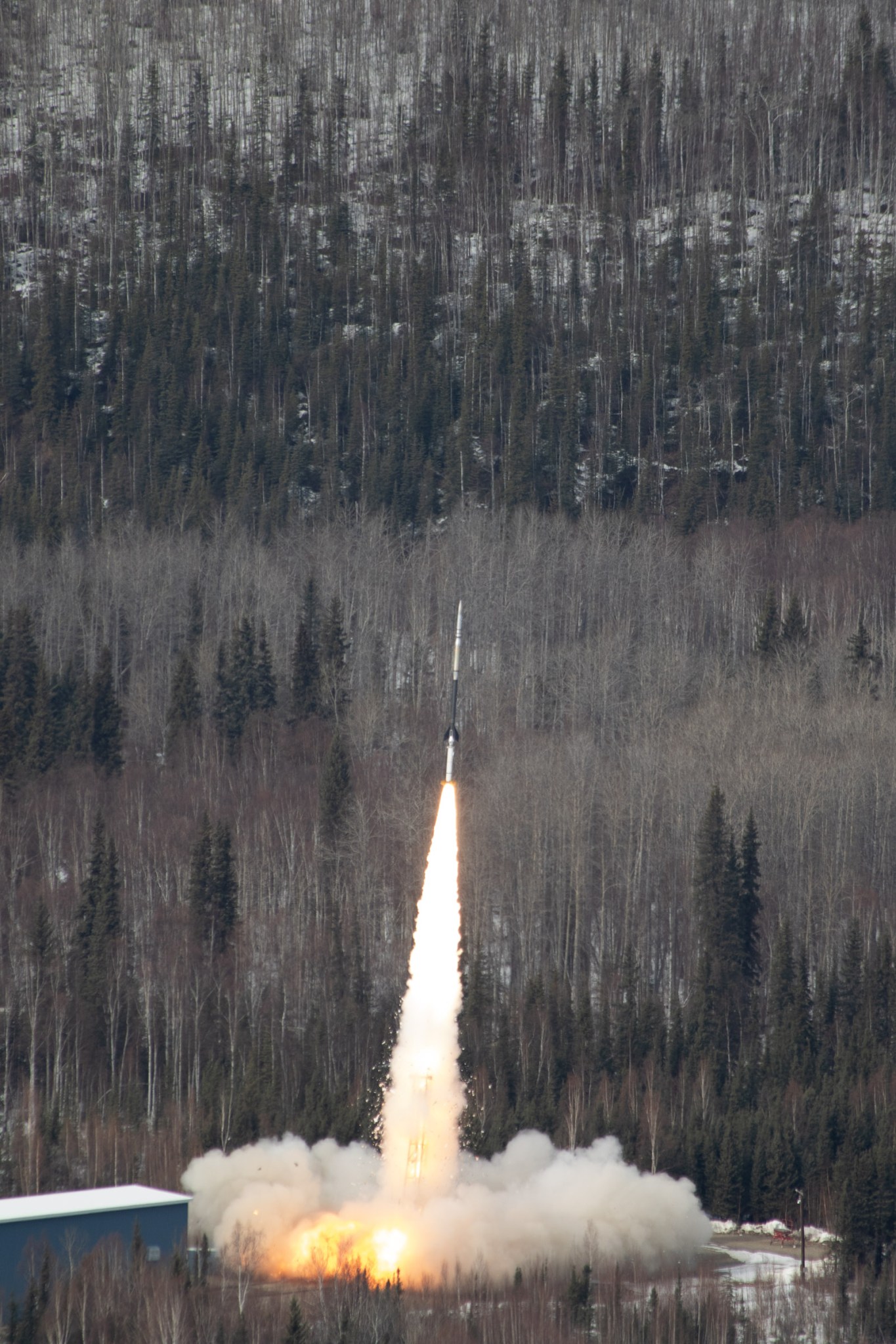 The High-Resolution Coronal Imager, or Hi-C, launches aboard a Black Brant IX sounding rocket April 17 at Poker Flat Research Range in Fairbanks, Alaska.NASA “This is a pioneering campaign,” said Sabrina Savage, principal investigator at Marshall for Hi-C Flare. “Launching sounding rockets to observe the Sun to test new technologies optimized for flare observations has not even been an option until now.”
The High-Resolution Coronal Imager, or Hi-C, launches aboard a Black Brant IX sounding rocket April 17 at Poker Flat Research Range in Fairbanks, Alaska.NASA “This is a pioneering campaign,” said Sabrina Savage, principal investigator at Marshall for Hi-C Flare. “Launching sounding rockets to observe the Sun to test new technologies optimized for flare observations has not even been an option until now.”
It was the third iteration of the Hi-C instrument to take flight, but its first flight with ride along instruments, including the COOL-AID (Coronal OverLapagram – Ancillary Imaging Diagnostics), CAPRI-SUN (high-CAdence low-energy Passband x-Ray detector with Integrated full-SUN field of view), and SSAXI (Swift Solar Activity X-ray Imager). Following a month of payload integration and testing in White Sands, New Mexico, investigators completed final launch site integration at the Poker Flat Research Range in Alaska.
Each morning of the two-week launch campaign window, the team spent about five hours preparing the experiment for launch, followed by up to four hours of monitoring solar data for a flare that registers as C5-class or higher with duration longer than the rocket flight. The launch finally occurred on the penultimate day of the campaign window.
“The Sun was unusually quiet throughout the campaign despite numerous active regions,” Savage said. “Both teams were getting nervous that we would not launch, but we finally got a nice long-duration M-class flare right before the window closed.”
The Hi-C Flare mission launched at 2:14 p.m. AKDT, just one minute after the FOXSI-4 (Focusing Optics X-ray Solar Imager) mission led by the University of Minnesota. Once in air, sensors on the Hi-C Flare rocket pointed cameras toward the Sun and stabilized instrumentation. Then, a shutter door opened to allow the cameras to gather about five minutes of data before the door closed and the rocket fell back to Earth.
The rocket landed in the Alaskan tundra, where it remained until conditions were safe enough for the team to retrieve it and begin processing the collected data.
“For launches into the tundra, we have to wait a few days for the instrument to get back to us and then to be dried out enough to turn on,” Savage said. “It was an anxious few days, but the data are beautiful and were worth the wait.”
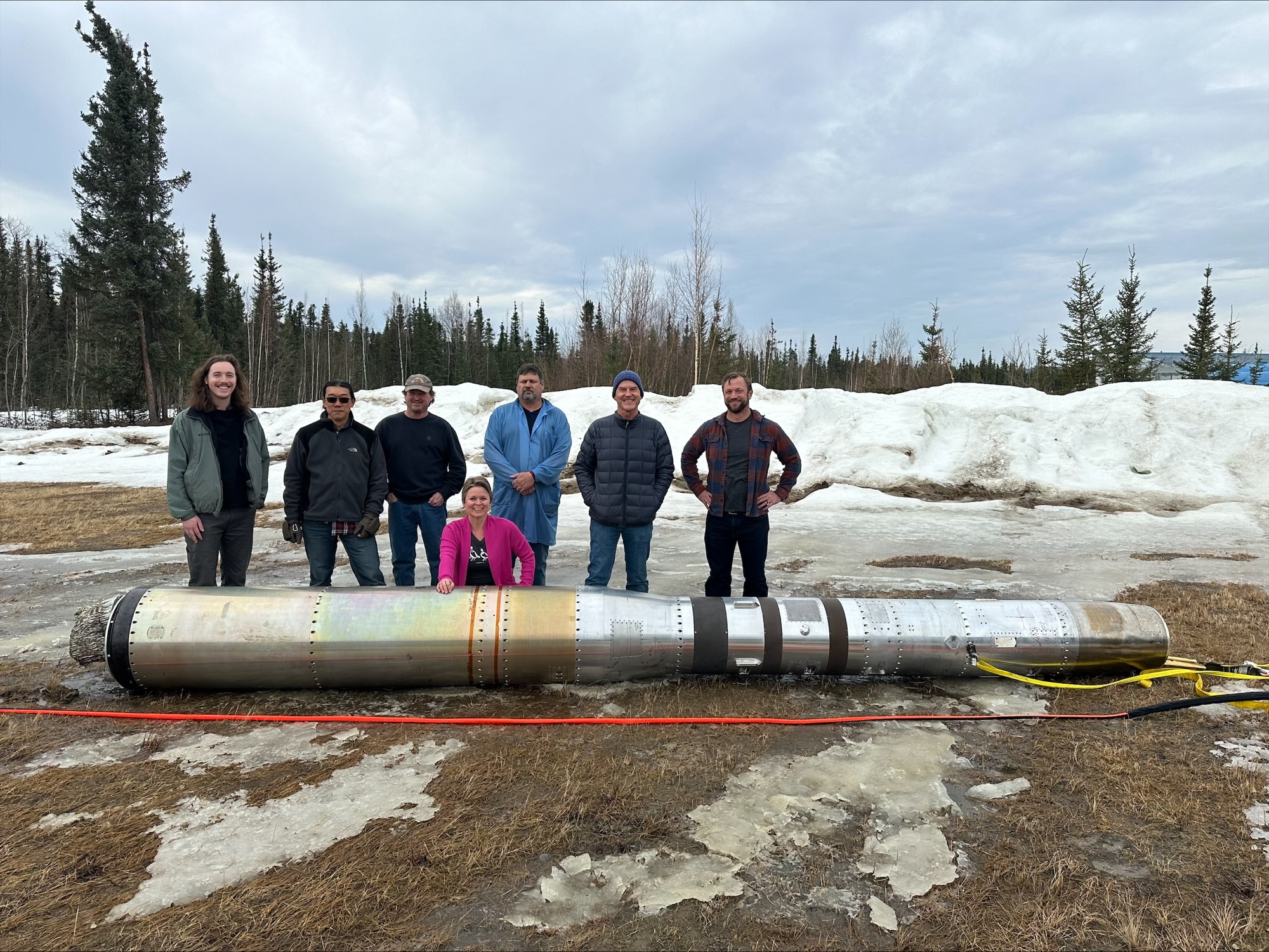 From left, Austin Bumbalough, Ken Kobayashi, Harlan Haight, Sabrina Savage, William Hogue, Jim Cecil, and Adam Kobelski, members of the Hi-C Flare team, gather after the payload was recovered and brought to Poker Flat Research Range in Alaska. Hi-C Flare, equipped with Hi-C 3, COOL-AID, CAPRI-SUN, and SSAXI, launched into a solar flare as part of the first-ever solar flare sounding rocket campaign.NASA Investigators weren’t just testing new technology, either. They also used a new algorithm to predict the behavior of a solar flare, allowing them to launch the rocket at the ideal time.
From left, Austin Bumbalough, Ken Kobayashi, Harlan Haight, Sabrina Savage, William Hogue, Jim Cecil, and Adam Kobelski, members of the Hi-C Flare team, gather after the payload was recovered and brought to Poker Flat Research Range in Alaska. Hi-C Flare, equipped with Hi-C 3, COOL-AID, CAPRI-SUN, and SSAXI, launched into a solar flare as part of the first-ever solar flare sounding rocket campaign.NASA Investigators weren’t just testing new technology, either. They also used a new algorithm to predict the behavior of a solar flare, allowing them to launch the rocket at the ideal time.
“To catch a flare in action is really hard, because you can’t predict them,” said Genevieve Vigil, technical and camera lead for Hi-C 3 and COOL-AID at Marshall. “We had to wait around for a solar flare to start going, then launch as it’s happening. No one has tried to do that before.”
Fortunately, their method was a success.
“We are still processing the data from all four instruments, but the data from Hi-C 3 and COOL-AID already look fantastic,” Savage said.
“The COOL-AID data is the first spectrally pure image in a hot spectral line that we know of,” said Amy Winebarger, project scientist at Marshall for Hi-C Flare.
The Hi-C experiment is led by Marshall in partnership with the Smithsonian Astrophysical Observatory in Cambridge, Massachusetts, and Montana State University in Bozeman, Montana. Launch support is provided at Poker Flat Research Range in Alaska by NASA’s Sounding Rocket Program at the agency’s Wallops Flight Facility, which is managed by NASA’s Goddard Space Flight Center. NASA’s Heliophysics Division manages the sounding-rocket program for the agency.
Barnett, a Media Fusion employee, supports the Marshall Office of Communications.
NASA Technology Grants to Advance Moon to Mars Space Exploration By Jessica Barnett
NASA has awarded nearly $1.5 million to academic, non-profit, and business organizations to advance state-of-the-art technology that will play a key role in the agency’s return to the Moon under Artemis, as well as future missions to Mars.
Twenty-four projects from 21 organizations have been awarded under NASA’s Dual-Use Technology Development Cooperative Agreement Notices, or CANs. The awardees also will receive assistance from propulsion, space transportation, and science experts at NASA’s Marshall Space Flight Center.
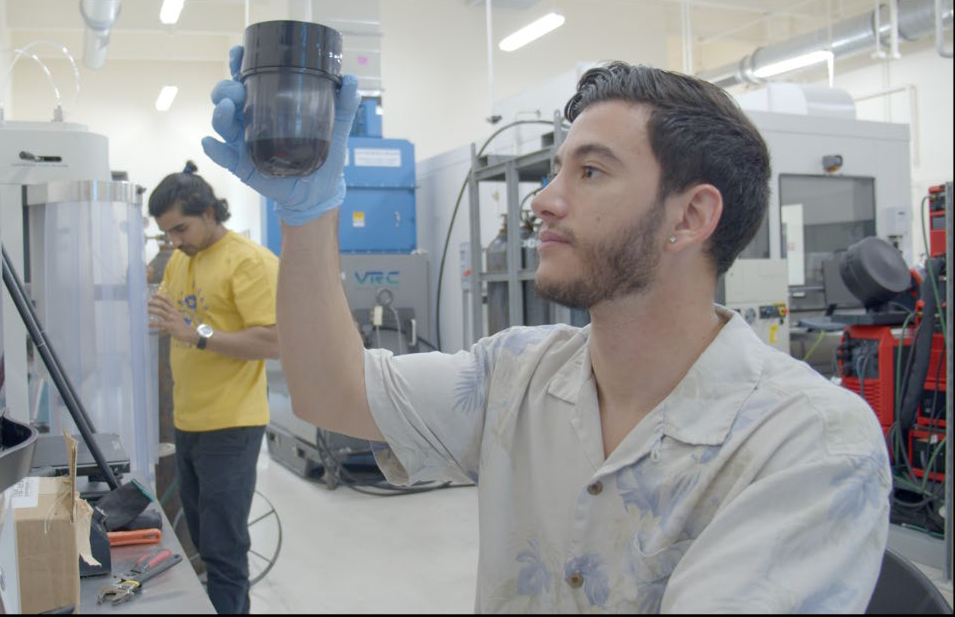 Brandon Aguiar, a graduate student at Florida International University, works to prepare a slurry containing a lunar regolith simulant, graphene nanoplatelets, and base resin for use in FIU’s ongoing study of the enhanced electrical conductivity of additively manufactured lunar regolith components involving graphene nanoplatelets.Credit: Florida International University “The Dual-Use Technology Development Cooperative Agreement Notice enables NASA to collaboratively work with U.S. industry and academia to develop needed technologies,” said Daniel O’Neil, manager, NASA Marshall’s Technology Development Dual-Use CAN Program. “Products from these cooperative agreements support the closure of identified technology gaps and enable the development of components and systems for NASA’s Moon to Mars architecture.”
Brandon Aguiar, a graduate student at Florida International University, works to prepare a slurry containing a lunar regolith simulant, graphene nanoplatelets, and base resin for use in FIU’s ongoing study of the enhanced electrical conductivity of additively manufactured lunar regolith components involving graphene nanoplatelets.Credit: Florida International University “The Dual-Use Technology Development Cooperative Agreement Notice enables NASA to collaboratively work with U.S. industry and academia to develop needed technologies,” said Daniel O’Neil, manager, NASA Marshall’s Technology Development Dual-Use CAN Program. “Products from these cooperative agreements support the closure of identified technology gaps and enable the development of components and systems for NASA’s Moon to Mars architecture.”
These innovative projects include ways to use lunar regolith for construction on the Moon’s surface, using smartphone video guidance sensors to fly robots on the International Space Station, identifying new battery materials, and improving a neutrino particle detector.
The following is a complete list of awardees:
Auburn University in Alabama Florida Institute of Technology in Melbourne, Florida Florida International University in Miami Fronius USA in Portage, Indiana Gloyer-Taylor Laboratories in Tullahoma, Tennessee Louisiana State University in Baton Rouge Morgan State University in Baltimore Nanoracks (Voyager Space) in Houston Northwestern University in Chicago Purdue University in West Lafayette, Indiana Southwest Research Institute in San Antonio Tethon 3D in Omaha, Nebraska University of Alabama in Huntsville University of California in Irvine University of Florida in Gainesville University of Illinois in Chicago University of North Texas in Denton University of Tennessee in Knoxville University of Tennessee Space Institute Victory Solutions in Huntsville, Alabama Wichita State University in Kansas The Florida Institute of Technology, Northwestern University, and the University of Alabama were awarded funding for two projects each.
Funding was available for organizations focused on supporting entrepreneurial research and innovation ideas that could advance the commercial space sector and benefit future NASA missions.
Applications are now open for the 2024 solicitation cycle.
Barnett, a Media Fusion employee, supports the Marshall Office of Communications.
IXPE General Observer Program Opens Doors to Global X-ray Astronomy By Rick Smith
Launched in late 2021, the science activities for NASA’s IXPE (Imaging X-ray Polarimetry Explorer) mission were directed by researchers at NASA and the Italian Space Agency through February 2024. Now, during the General Observer phase of the mission, IXPE’s observation program primarily is guided by the broader scientific community.
“We’re in the process of turning X-ray polarization into a standard part of the toolkit for X-ray astronomers around the globe,” said Philip Kaaret, IXPE principal investigator at NASA’s Marshall Space Flight Center. “The response across the high-energy astrophysics community has been tremendous.”
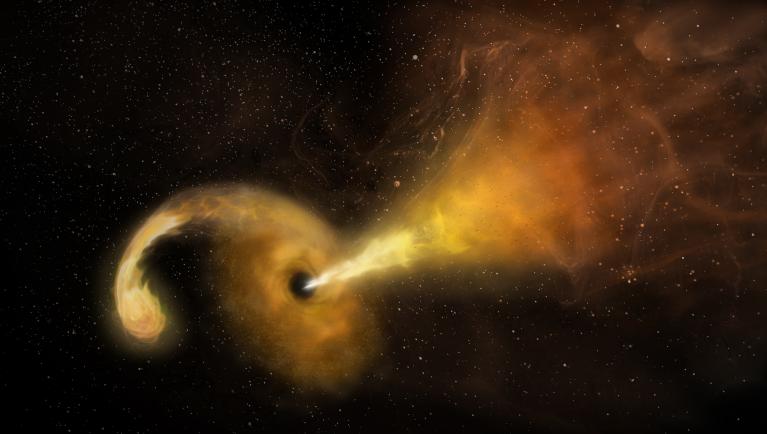 IXPE will help researchers gain new understanding of the forces involved in a tidal disruption event, as seen in this artist’s illustration depicting what happens when a star passes fatally close to a supermassive black hole.NRAO/AUI/NSF/NASA The General Observer Program, which officially began in February, invites astrophysicists and space scientists around the world to propose exciting new investigations of black holes, neutron stars, active galactic nuclei, and other high-energy X-ray sources using the IXPE telescope.
IXPE will help researchers gain new understanding of the forces involved in a tidal disruption event, as seen in this artist’s illustration depicting what happens when a star passes fatally close to a supermassive black hole.NRAO/AUI/NSF/NASA The General Observer Program, which officially began in February, invites astrophysicists and space scientists around the world to propose exciting new investigations of black holes, neutron stars, active galactic nuclei, and other high-energy X-ray sources using the IXPE telescope.
In the spacecraft’s first two years of operation, NASA’s research partners included more than 175 scientists in 13 countries – and interest continues to swell. Proposed investigations submitted to date to the General Observer Program involve more than 1,400 researchers at 174 unique institutions in 30 countries.
“Our chief goal to enable every interested party to use, analyze, and interpret IXPE data,” said Kavitha Arur, program lead at NASA’s Goddard Space Flight Center. “We want to maximize science outputs and cover the widest possible range of targets.”
In June 2023, NASA issued an open invitation to researchers to propose new IXPE missions and targets of observation. By the October 2023 deadline, the General Observer Program team had received 135 proposals for Cycle 1, covering the first year of the program. Each proposal was exhaustively peer-reviewed by NASA astrophysicists and associated experts in the field.
Researchers proposed studies based on the number of seconds of IXPE target observation they estimated they would need to obtain the data necessary to verify a hypothesis or model.
For Cycle 1, the team selected 39 proposals, totaling about 15 million seconds of total observation time. That figure will include some overlap among selected targets – and the targets selected included a few surprises.
“Some of the selected proposals were for types of targets we hadn’t previously considered, such as tidal disruption events,” Kaaret said. A tidal disruption event is when a star is pulled into a supermassive black hole and torn apart.
Cycle 1 researchers also will, for the first time, use IXPE to study a white dwarf, a stellar core remnant roughly the size of Earth but with a mass comparable to that of our Sun. That white dwarf is part of the binary system T Coronae Borealis, roughly 3,000 light years from our solar system. “T CrB,” as it’s known to astronomers, also includes an ancient red giant which emits a nova eruption every 80 years or so. It was last seen in 1946, and astronomers anticipate another eruption between now and September 2024. For stargazers on Earth, this nova will appear to be a star that wasn’t there before.
That wide window of time makes T CrB a “target of opportunity” for IXPE – an unpredictable wrinkle in the meticulously plotted Cycle 1 schedule. Such an event requires quick reaction on the part of the team to enable IXPE to point at it without a lot of advanced scheduling.
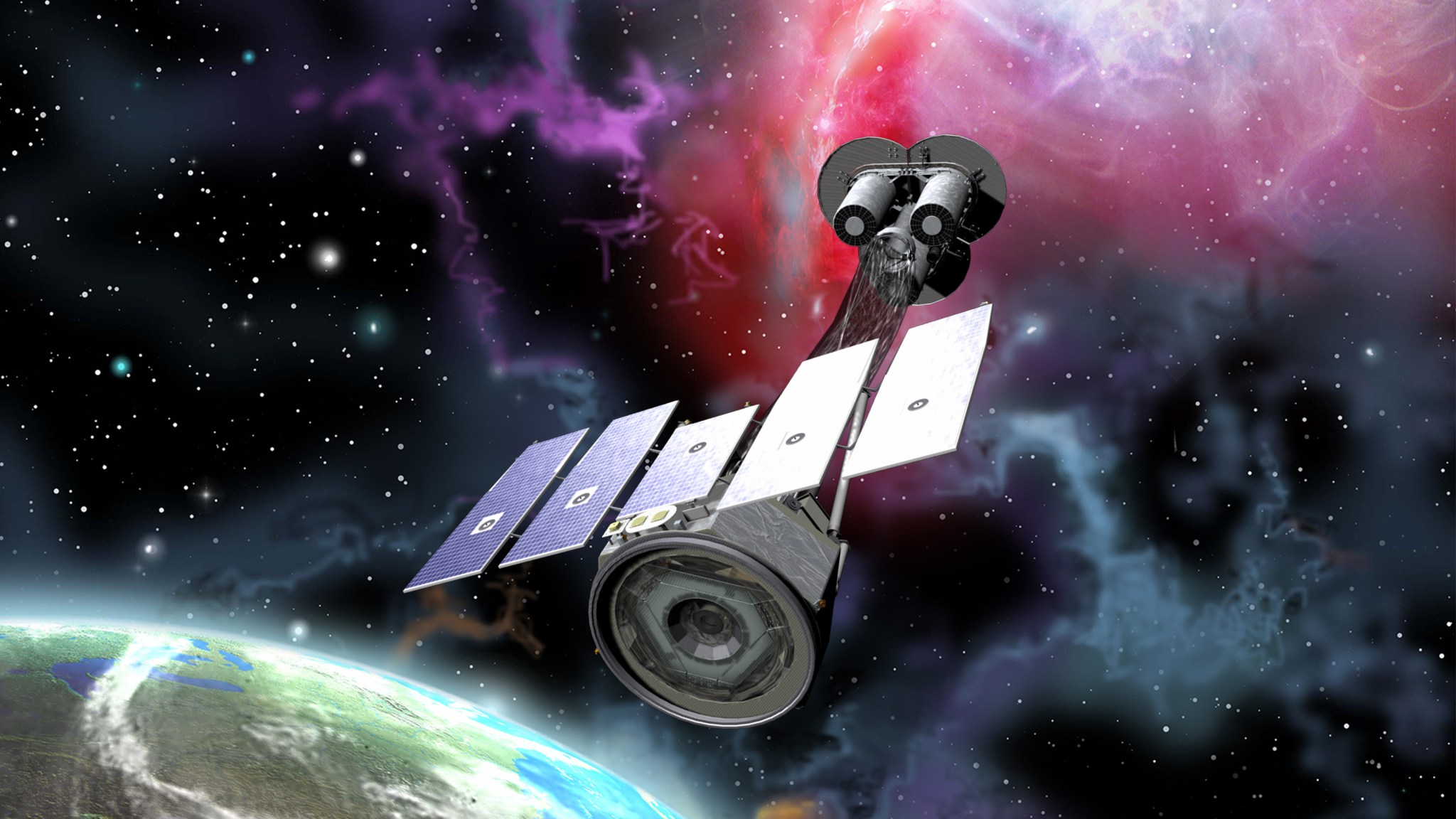 An artist’s illustration of the IXPE spacecraft in orbit, studying high-energy phenomena light-years from Earth.NASA Allyn Tennant, who heads IXPE’s science operations center at Marshall, is tasked with mapping out IXPE’s timetable. He factors in the precise duration of each observation, the time needed to download its findings, and the necessary repositioning time between targets.
An artist’s illustration of the IXPE spacecraft in orbit, studying high-energy phenomena light-years from Earth.NASA Allyn Tennant, who heads IXPE’s science operations center at Marshall, is tasked with mapping out IXPE’s timetable. He factors in the precise duration of each observation, the time needed to download its findings, and the necessary repositioning time between targets.
What does it take to execute such a complex plan? “A certain amount of thought, a certain amount of swearing, and a whole lot of replanning,” Tennant said.
“We started the program the first week of February and by late April, Allyn had already rescheduled the plan seven times,” Kaaret added. “It makes for some stressful weekends, but a lot of really exciting results come from these unanticipated events.”
IXPE spends about a week on each target, on average, so it’s not hard to schedule roughly 40 targets in a 52-week window, Tennant said – until one encounters those targets of opportunity. There’s also the challenge of managing the inflow of data from each observation. The brighter the target, the bigger the volume of incoming data that must be captured, verified, and distributed to the investigators.
The spacecraft’s busy schedule also factors in joint astronomical observations with other NASA instruments conducting their own orbiting science missions. Those joint efforts further extend the value of data gathered during IXPE’s General Observer Program studies but add another level of complexity when targets of opportunity call for reshuffling the schedule.
During Cycle 1 and Cycle 2, IXPE is teaming with NASA’s NICER (Neutron Star Interior Composition Explorer) X-ray observatory, which studies neutron stars, black holes, and other phenomena from its permanent vantage point aboard the International Space Station. In Cycle 2, beginning in February 2025, the program also will partner with NASA’s orbiting Swift and NuSTAR (Nuclear Spectroscopic Telescope Array) imagers, which monitor gamma-ray bursts and high-energy cosmic X-ray events, respectively.
The growing interest in IXPE’s success led USRA’s Science and Technology Institute to announce the first IXPO (International X-ray Polarimetry Symposium), to be held in Huntsville on Sept. 16-19. Astronomers, engineers, and X-ray technologists are encouraged to attend.
View the complete list of selected IXPE Cycle 1 research proposals. Learn more about program guidelines for submitting Cycle 2 proposals.
IXPE, led by NASA Marshall, is a collaboration between NASA and the Italian Space Agency. The Space & Mission Systems division of BAE Systems Inc., in Broomfield, Colorado, manages spacecraft operations together with the University of Colorado’s Laboratory for Atmospheric and Space Physics in Boulder.
Smith, a Manufacturing Technical Solutions Inc. employee, supports the Marshall Office of Communications.
NASA Selects Students for Europa Clipper Intern Program NASA has selected 40 undergraduate students for the first year of its Europa ICONS (Inspiring Clipper: Opportunities for Next-generation Scientists) internship program, supporting the agency’s Europa Clipper mission. Europa ICONS matches students with mentors from the mission’s science team for a 10-week program to conduct original scientific research on topics related to the mission to Jupiter’s moon Europa.
The program is planned to run every year until Europa Clipper completes its prime mission in 2034 and is open to applications from all U.S. undergraduate STEM majors, with preference given to students from non-high research activity universities and underserved institutions.
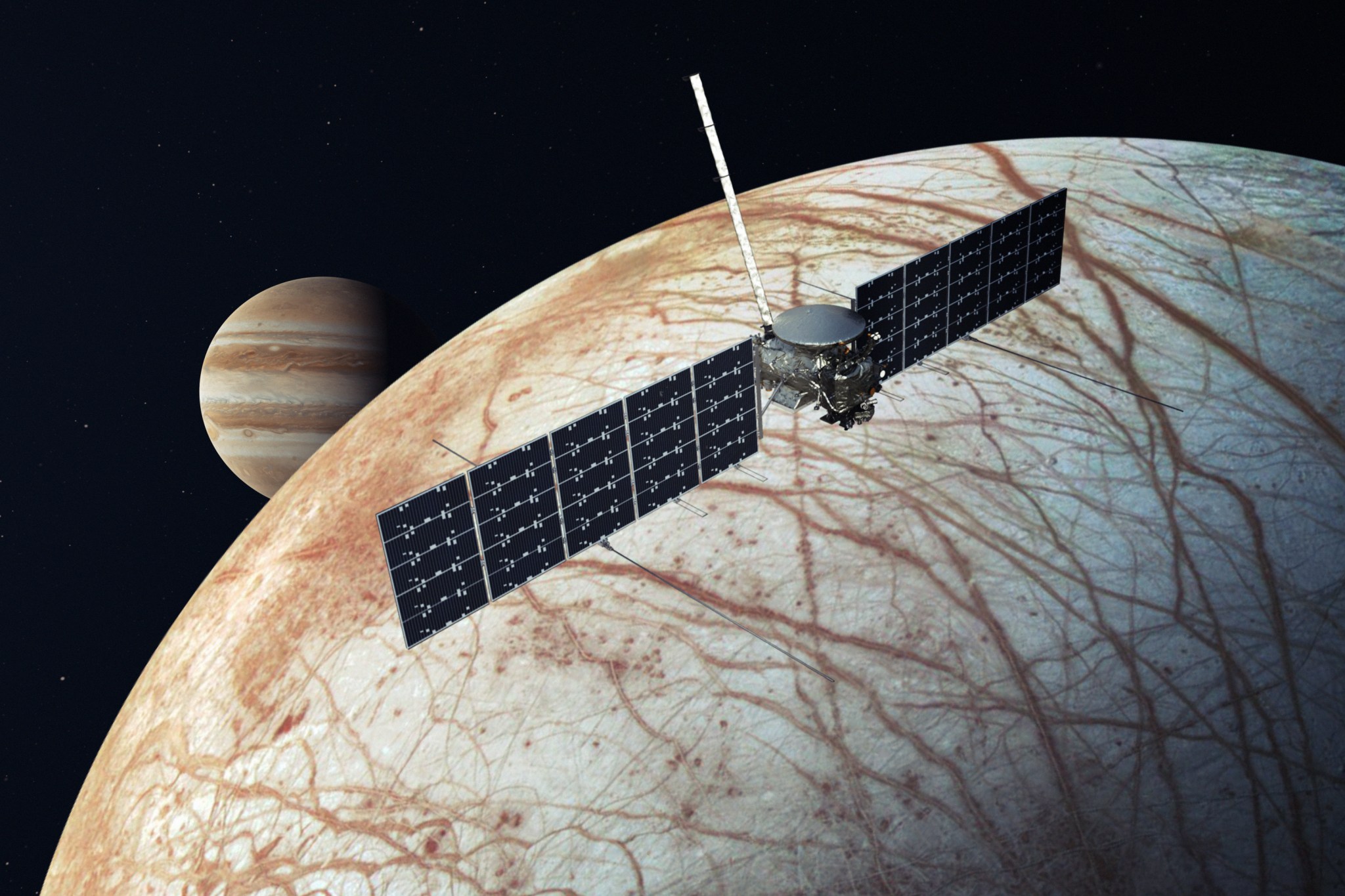 Artist’s rendering of NASA’s Europa Clipper spacecraft.NASA/JPL-Caltech ICONS internships may be in-person at the mentor’s institution, virtual, or hybrid, depending on the research project and needs of the mentor and intern. As part of the program, students and mentors will convene for a two-day meeting at NASA’s Jet Propulsion Laboratory (JPL). The first Europa ICONS internship will run June 3 through Aug. 9.
Artist’s rendering of NASA’s Europa Clipper spacecraft.NASA/JPL-Caltech ICONS internships may be in-person at the mentor’s institution, virtual, or hybrid, depending on the research project and needs of the mentor and intern. As part of the program, students and mentors will convene for a two-day meeting at NASA’s Jet Propulsion Laboratory (JPL). The first Europa ICONS internship will run June 3 through Aug. 9.
The students selected for the Europa ICONS program in 2024 are:
Sarah Ruetschle, John Carroll University in University Heights, Ohio Cole Anderson, University of California, Santa Cruz Hamza Ouriour, Wentworth Institute of Technology in Boston Ethan Piacenti, Olivet Nazarene University in Bourbonnais, Illinois Jared Bouck, Northern Arizona University in Flagstaff, Arizona Kayla Blair, Northern Arizona University Carly Davis, McNeese State University in Lake Charles, Louisiana Matthew Perkins, Red Rocks Community College in Lakewood, Colorado Angela Zhang, Cornell University in Ithaca, New York Arianna Rodriguez Ortiz, University of Puerto Rico–Mayaguez Beverly Malugin Ayala, University of Puerto Rico–Mayaguez Jeansel Johnson-Ayala, University of Puerto Rico–Rio Piedras Akemi Takeuchi, University of Maryland, College Park Sofia Merchant-Dest, University of Maryland–University College in Adelphi Gradon Robbins, University of Florida in Gainesville Jason Sioeng, California State Polytechnic University, Pomona Tyler Yuen, San Jose State University in San Jose, California Dallin Nelson, Southern Utah University in Cedar City Eric Stinemetz, University of Houston–Downtown Lucas Nerbonne, Middlebury College in Middlebury, Vermont Hope Jerris, Middlebury College Jacob Dietrich, Indiana University, Southeast in New Albany Jocelyn Mateo, Lorain County Community College in Elyria, Ohio Samuel Brown, San Diego Mesa College in San Diego Madison Stanford, Loyola Marymount University in Los Angeles Bryce McGimsey, Solano Community College in Fairfield, California Noah Alayon, CUNY LaGuardia Community College in Queens, New York Trevor Erwin, University of Texas at Austin Ava Frost, Mount Holyoke College in South Hadley, Massachusetts Brianna Casey, Rensselaer Polytechnic Institute in Troy, New York Fatima Mendoza, Texas Tech University in Lubbock Daniel Voyles, Harvey Mudd College in Claremont, California Swaroop Sathyanarayanan, Georgia Institute of Technology in Atlanta Jay Patel, Louisiana State University College of Engineering in Baton Rouge Juliane Keiper, Amherst College in Amherst, Massachusetts Emori Long, Florida Agricultural and Mechanical University in Tallahassee Scott Chang, University of Wisconsin–Madison Hayden Ferrell, Arizona State University in Tempe Isabella Musto, Denison University in Granville, Ohio Elizabeth Kirby, College of Charleston in Charleston, South Carolina The Europa Clipper mission’s three main science objectives are to determine the thickness of the moon’s icy shell and its surface interactions with the ocean below, to investigate its composition, and to characterize its geology. The mission’s detailed exploration of Europa will help scientists better understand the astrobiological potential for habitable worlds beyond our planet.
The Europa ICONS program is managed by the Planetary Science Division within NASA’s Science Mission Directorate and is part of a larger effort known as Clipper Next Gen, a decade-long strategy using the Europa Clipper mission to train and diversify the next generation of planetary scientists.
Managed by Caltech in Pasadena, California, JPL leads the development of the Europa Clipper mission in partnership with the Johns Hopkins Applied Physics Laboratory (APL) in Laurel, Maryland, for NASA’s Science Mission Directorate. APL designed the main spacecraft body in collaboration with JPL and NASA’s Goddard Space Flight Center. The Planetary Missions Program Office at NASA’s Marshall Space Flight Center executes program management of the Europa Clipper mission.
Hubble Views a Galaxy with a Voracious Black Hole Bright, starry spiral arms surround an active galactic center in a new NASA Hubble Space Telescope image of the galaxy NGC 4951.
Located in the Virgo constellation, NGC 4951 is located roughly 50 million light-years away from Earth. It’s classified as a Seyfert galaxy, which means that it’s an extremely energetic type of galaxy with an active galactic nucleus (AGN). However, Seyfert galaxies are unique from other sorts of AGNs because the galaxy itself can still be clearly seen – different types of AGNs are so bright that it’s nearly impossible to observe the actual galaxy that they reside within.
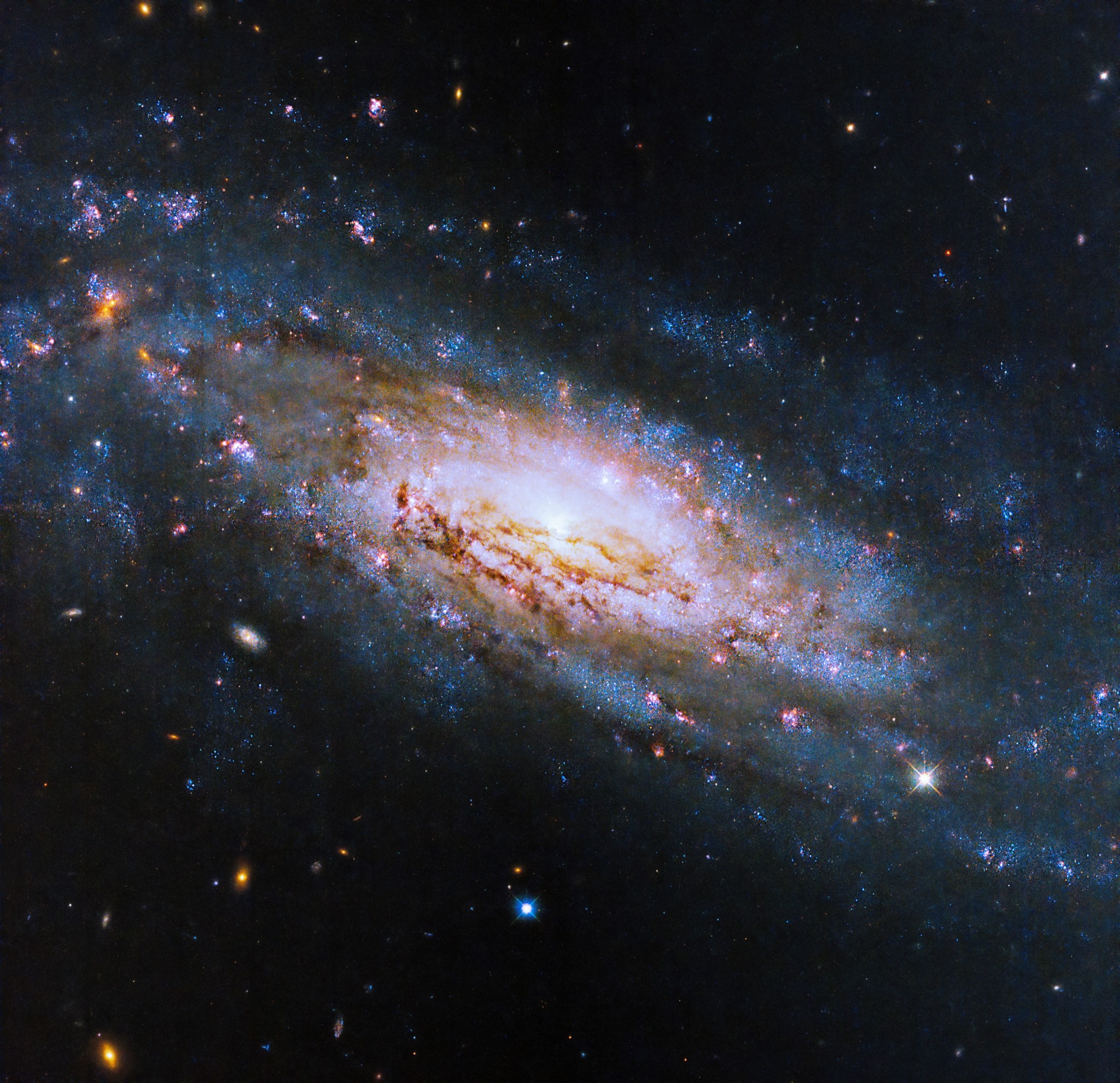 Bright, starry spiral arms surround an active galactic center in this new NASA Hubble Space Telescope image of the galaxy NGC 4951.NASA, ESA, and D. Thilker (The Johns Hopkins University); Image Processing: Gladys Kober (NASA/Catholic University of America) AGNs like NGC 4951 are powered by supermassive black holes. As matter whirls into the black hole, it generates radiation across the entire electromagnetic spectrum, making the AGN shine brightly.
Bright, starry spiral arms surround an active galactic center in this new NASA Hubble Space Telescope image of the galaxy NGC 4951.NASA, ESA, and D. Thilker (The Johns Hopkins University); Image Processing: Gladys Kober (NASA/Catholic University of America) AGNs like NGC 4951 are powered by supermassive black holes. As matter whirls into the black hole, it generates radiation across the entire electromagnetic spectrum, making the AGN shine brightly.
Hubble helped prove that supermassive black holes exist at the core of almost every galaxy in our universe. Before the telescope launched into low-Earth orbit in 1990, astronomers only theorized about their existence. The mission verified their existence by observing the undeniable effects of black holes, like jets of material ejecting from black holes and disks of gas and dust revolving around those black holes at very high speeds.
These observations of NGC 4951 were taken to provide valuable data for astronomers studying how galaxies evolve, with a particular focus on the star formation process. Hubble gathered this information, which is being combined with observations with the James Webb Space Telescope (JWST) to support a JWST Treasury program. Treasury programs collect observations that focus on the potential to solve multiple scientific problems with a single, coherent dataset and enable a variety of compelling scientific investigations.
NASA’s Marshall Space Flight Center was the lead field center for the design, development, and construction of the space telescope.

